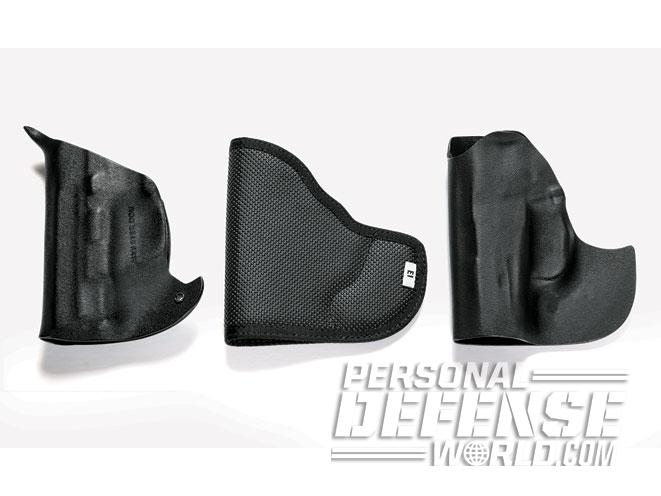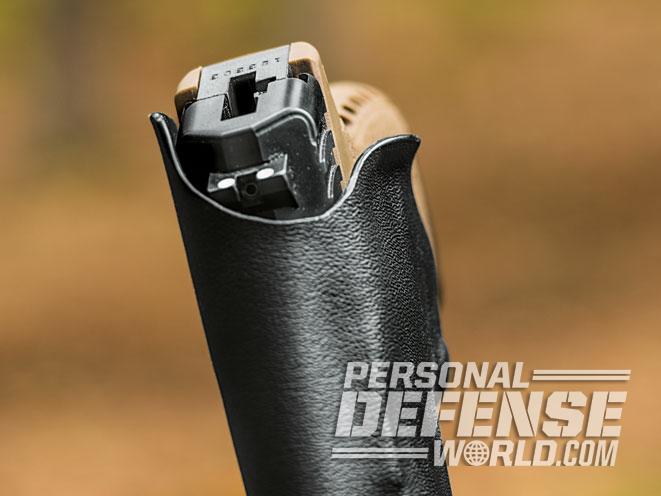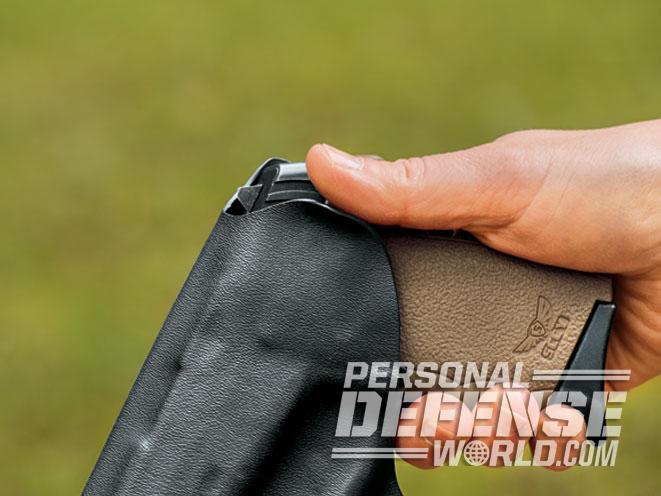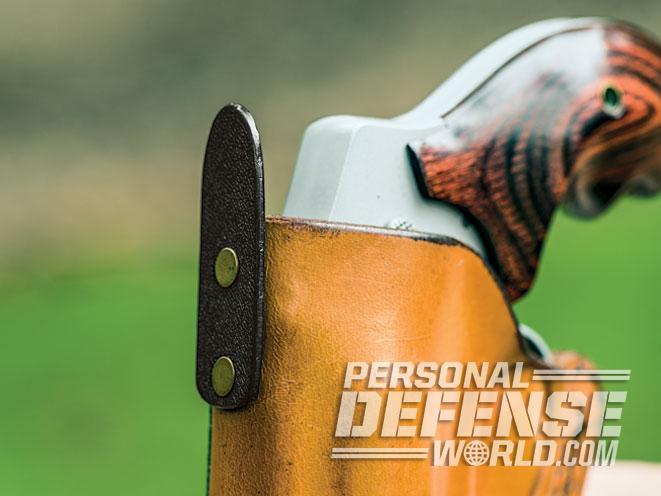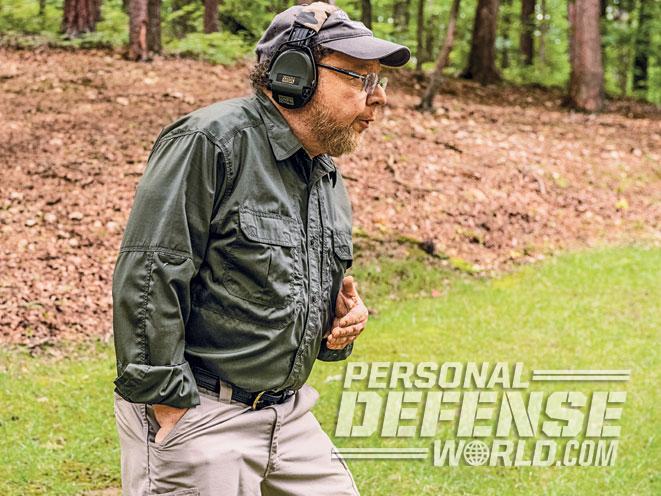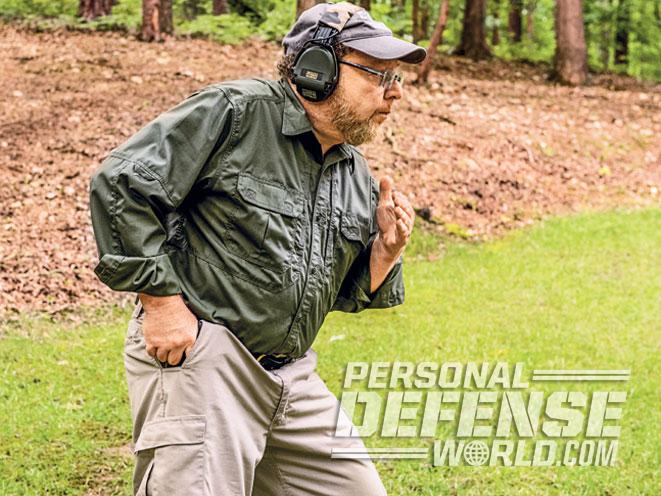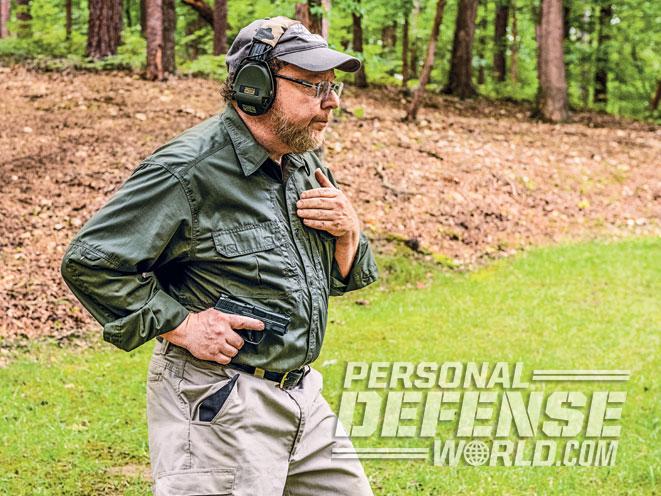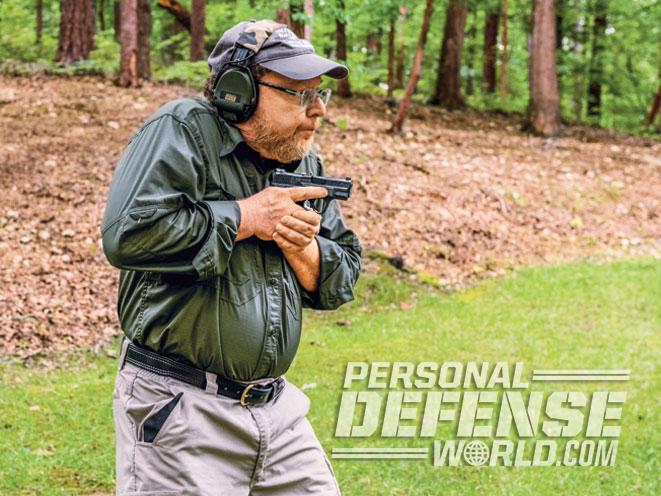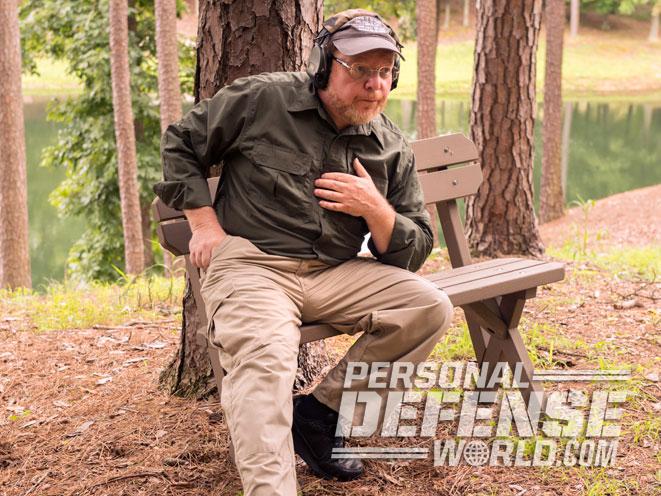I consider pocket carry to be one of the best kept secrets in personal defense. Used for either primary or backup carry, pocket carry has numerous benefits. Perhaps the biggest is that it is very discreet. It allows you to carry a gun in situations and places where traditional belt carry would not work. If you are at a social function where hugging is common, or a business environment where close contact is anticipated, a pocket gun won’t be discovered accidently or by a bump frisk as a belt-borne holster may. I have pocket carried a handgun for many years without anyone being the wiser.
Carrying a gun in your pocket can also have a great speed advantage. With your hand in your pocket, already wrapped around the grip of your gun, your draw time is cut in half. Walking or standing with your hand in your pocket is quite normal, non-threatening and non-confrontational. No one will suspect that you have a gun in hand, ready to go at a moment’s notice.
Using a holster with pocket carry is as essential as it is for belt carry. A pocket holster will keep the gun upright in your pocket, keeping it from rolling over, which would make it difficult to grip quickly in an emergency. The holster covers the trigger, keeping you safe from negligent discharges.
Advertisement — Continue Reading Below
Even with use of a pocket holster, it is imperative that you do not to place anything else in your pocket as it could interfere with your grip, the draw stroke, cause a negligent discharge or bind the gun within the holster. Lastly, a pocket holster disguises the shape of the gun within your pocket. Your pocket may still bulge, but the print shape won’t be recognized as a gun. It will look more like a wallet.
Fast Access

Depending on the design, some pocket holsters are reversible and can be used on either side of your body. If not, you may want to consider purchasing both a left- and right-handed holster so you can carry on your dominant side for primary weapon carry, or on the support side for use as a backup gun. With two holsters, you can pocket carry both your primary and back-up weapons.
Advertisement — Continue Reading Below
An important consideration for pocket carry is that the pockets in your pants are wide enough to accommodate the size of your hand while holding the grip of your gun. If not, it will be difficult to retrieve your weapon. The pocket also needs to be deep enough so that the gun’s grip does not protrude visibly from the pocket. If need be, a tailor can easily lengthen a pocket.
RELATED STORY: Massad Ayoob’s 5 Methods of Concealed Quick-Draw
A tip for shopping for pants for pocket carry is to measure the pocket opening of a pair of pants that works well for your hand/gun size. Carry a tape measure or cut a strip of paper to that length, and use it to measure the pockets of pants while they are on the store rack. This will save you from having to try on lots of pants to check pocket size.
Advertisement — Continue Reading Below
I have been very pleased with Tru-Spec tactical cargo pants. The pockets are deep enough and have a wide enough opening for pocket carry. The waistband is elastic, so I can wear them with or without an inside-the-waistband (IWB) holster, without needing to buy an over-large waist size.
The pant leg is also cut large enough to accommodate ankle carry if so desired. The pants work well for any method of carry. When it comes to more formal dress wear, look for pants that have double-pleated pockets. The pleats offer more room and help to reduce the bulge of the holster.
Close-Quarters Response
Advertisement — Continue Reading Below

The draw stroke for pocket carry is quite similar to that of a strong-side belt holster. Once your hand is on the gun’s grip, lift the gun out of the pocket, immediately turn it 90 degrees so it is pointing at the threat, raise it up the side of your body to meet your support hand at your chest, then extend toward the target.
This Right-Angle Draw Stroke, sometimes called a Close-Quarters or Tactical Draw Stroke, works for both near and distant targets. Keeping the gun close to the body before full extension allows you to draw when seated behind a table or desk, or in close proximity of any object. Rotating the gun towards the threat immediately after retrieval from the pocket enables you to shoot immediately if needed. Keeping the gun aimed at the threat as you raise it up the side of your body and extend it toward the target allows you to shoot throughout the entire draw stroke in an emergency.
RELATED STORY: Concealed Carry Holster & Belt Combos For Full-Size Handguns
Advertisement — Continue Reading Below
While the pocket carry draw stroke is the same as a belt-borne holster, unlike belt carry a specific and distinct action is required to separate the gun from the pocket holster. The method used for the separation depends on the type of holster that you are using. There are three types of pocket holsters, each with its own method of separating the gun from the holster: hook holster, push-off holster and friction holster.
The hook holster has a hook at the upper corner of the holster that is designed to hook the holster within the top corner of the pocket as you lift the gun out of the pocket. The hook is either integrated directly into the design of the holster itself or an as an add-on tab—both work perfectly well.
With the hook holster, when you lift the gun out of the pocket you need to do so in a diagonal direction towards your belt buckle. This will ensnarl the holster’s hook into the corner of the pocket, releasing it from the gun during the draw. The holster might remain in the pocket or it may even fall on the ground. No matter if it does. The only important thing is that the holster is separated from the gun. If you draw straight upwards with a hook holster, the holster’s hook may very well miss the pocket edge and stay on the gun as you draw—not a good situation.
Advertisement — Continue Reading Below

The second type of pocket holster is the push-off design. This holster has a ledge integrated into the design of the holster that is used to push the holster off the gun with your thumb. The fastest method is to push the holster off the gun at the same time as you lift it from the pocket. If you anticipate trouble, you can even push the holster off the gun before the draw, with the gun remaining in the pocket. Again, the holster may stay in the pocket or land on the floor. You’re good to go as long as the holster does not remain on the gun.
The last pocket holster option is the friction design. These holsters are designed to remain in the pocket through the use of a tacky fabric/rubber on the exterior of the holster. These types of holsters tend to offer a somewhat loose fit to the gun, which makes separation during the draw more likely.
The success of the separation depends a lot on the tightness of the pocket. The tighter the pocket, the more likely that the friction will keep the holster within the pocket during the draw. Looser pockets can be somewhat problematic. Friction holsters may work fine in one pair of pants, but not in another.
Advertisement — Continue Reading Below
I found that the solution to this is problem is to press the gun (while still in the holster) against your leg during the draw. The added pressure pushing the tacky fabric/rubber against your body will help ensure that the holster remains in the pocket as you draw.
Out Of Sight

When it’s time to reholster, the best method with all three holster concepts is to remove the holster from the pocket, insert the gun and then reseat the holster in the pocket. Trying to reholster with the holster still in the pocket can be problematic.
Advertisement — Continue Reading Below
One downside to pocket carry is that it can be difficult to draw when seated. To alleviate that issue, lean away from your gun side and extend your gun-side leg. This will make it easier to get your hand in and out of your pocket.
Regardless of which of the three holster types you choose, pocket carry requires a gun that can be easily pulled out of a pocket. This is a matter of both size and shape.
RELATED STORY: The Pros and Cons of 7 Concealed Carry Holster Types for Women
If you carry a snub-nose revolver, the rounded, smooth shapes of internal-hammered designs, shrouded-hammer designs or spurless revolvers work best as there is nothing to get caught and bind them within the pocket. If your revolver has a hammer spur, cover the spur with your thumb as you draw to keep the spur from getting caught on the pocket. Alternatively, you can have a gunsmith remove the hammer spur.
With semi-automatic pistols, I find that square-backed slides can get caught on the pocket and foul the draw stroke. I tend to prefer pistols with angled slides, as these draw best from the tight confines of a pocket.
When choosing a pistol or snubby for pocket carry, test them by purposely trying to bind it in the pocket during the draw. The guns that don’t bind, regardless of how hard you try, are the best options for pocket carry.
Better Backup
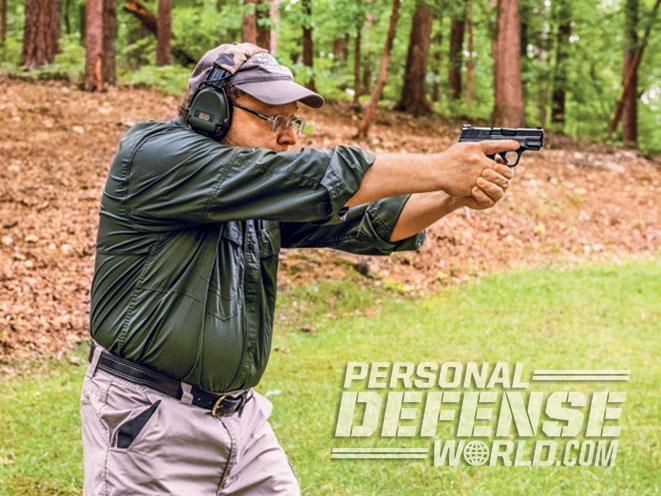
One of the phenomena that has been realized with scenario-based training in regards to backup guns is that shooters often forget that they are carrying a backup gun.
As hard as that is to believe, it can all be traced back to a function of training. Those who forgot that they had a backup gun with them trained with their backup gun alone, meaning that they did not integrate the backup weapon into training with their primary weapon. They shot their primary weapon, put it away, then they shot their backup.
RELATED STORY: 37 Holsters For Every Style Of Concealed Carry
The best procedure is to start a firing string with your primary weapon, simulate an outage or stoppage, then follow up with a full-speed transition to your backup firearm. When your primary weapon fails, drop it on the ground, then draw your backup.
When it comes to a real fight, don’t worry about the bad guy getting the gun that you dropped. If it doesn’t work for you, it won’t work for the bad guy either. I bring a blanket or towel to the range with me to drop my primary gun on to so it does not get damaged. It is essential to practice the same exact techniques that you would use in a real-life scenario to defend yourself or your loved ones. Train and stay safe.

